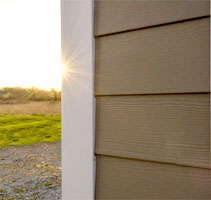by Mark Petersen
1/20/2020

Now that you have decided to replace your siding and chosen a local contractor, you can look forward to having work begin.
While no two jobs are exactly the same, there are some steps that nearly all siding replacement projects have in common. Here's what you can generally expect from the re-side process, including ways to prepare, questions to ask throughout the process, and plenty of other helpful information to help your project go as smoothly as possible.
What You Can Do To Prepare
There are several ways that you can prepare your home and property. These tasks can help speed up work and keep your property safe during construction.
• Clear a power outlet. The crew will need access to power for their tools, so it’s helpful to have a clear outlet available (preferably one that is on a 20-amp circuit).
• Prepare the inside of your house. Siding removal and installation will cause your walls to shake. Remove items that are leaning against or hanging on walls, and those located on shelves, as they may fall.
• Prepare the outside of your home. Move anything that may block access to your exterior walls such as firewood or patio furniture so the crew can get right to work. You should also consider removing outdoor decorations and wrapping shrubbery in landscaping canvas to prevent any accidental damage. Cutting your grass short will help your crew find nails or other debris that go astray.
• Make alternate arrangements. Construction is a loud process, which is completely unavoidable. If you work from home, you may want to consider making alternate arrangements. If you have pets, you may want to make other arrangements for them as well.
What to Expect Before Construction
You can expect a dumpster and your new siding to be delivered, sometimes a day or two before the installation crew arrives. Some municipalities may require a permit for a dumpster, along with other building permits, so be sure to discuss those details with your contractor beforehand.
Not all municipalities will allow dumpsters or building materials to be left on the street, so let the crew supervisor know exactly where in your driveway you want them to be placed. The crew will want them as close to the house as possible, but you may not want to block access to your garage. Dumpsters are extremely heavy, so if you’re concerned about damage to your driveway ask the driver to place wood under the pressure points.
The Re-Side Work Begins
When the crew arrives, they will get oriented with your property and begin to set up work stations. Once they’re ready, their first step will be to remove your existing siding.
Some crews will only tear off one side of the house at a time to prevent leaving walls exposed to the weather. Larger crews may remove all of the siding right away.
It’s important to keep safety in mind during the re-side process. A good crew will clean up as they work and at the end of each day, but a siding replacement project can be a messy business. Always assume there are nails on the ground and wear sturdy shoes or boots when walking in your yard while construction is underway.
During construction, your contractor may leave their scaffolding in place overnight. To prevent accidents, keep an eye on your children and warn neighbors with children to stay clear of the construction site.
Unexpected Repairs
The best opportunity to discover and repair damage to your home is when your old siding has been removed. These unexpected issues may seem like trouble, but it’s best to know about and fix them before your brand new siding is installed.
No contractor will know exactly what to expect without tearing off all of the existing siding. However, a seasoned local contractor should have an idea as they have likely worked on similar homes in your neighborhood. They may even know who built your home, and the type of building materials and construction techniques they used.
The best way to handle unexpected issues is to clearly communicate with your contractor. Ask them what types of issues they may expect to encounter and how they will be communicated to you. Then, you can both determine how to best remedy the situation.
New Siding Installation

After the siding is off and repairs are made, your contractor may install or replace the weather resistant barrier (WRB) on your home, which is also referred to as house wrap. A WRB protects your home by providing water resistance and breathability to your house structure.
Finally, the crew will begin to install your new siding and trim.
How Long Does a Re-Side Take?
Every house is different, but a typical tear-off and siding installation project may take between 7 to 14 days. There are many things that can extend the time such as the size of your house, whether you’re using prefinished siding or if it needs to be painted, and unexpected repairs. Bad weather can also be a factor and there may be some downtime waiting for building inspections.
Conversations and Cooperation

It’s important to inspect every wall and discuss any concerns with the job supervisor before the crew leaves. But it’s just as important to have a conversation before the work gets started. Talk to your contractor about start and stop times, which home or yard features to look out for, your tolerance for loud music, parking preferences, weekend working hour options, etc.
Construction can be a hard, physically demanding job, but most siding installers are true professionals. Learn their names. Have daily conversations with them. A good relationship with your crew will help ensure you have a great siding replacement experience.





































